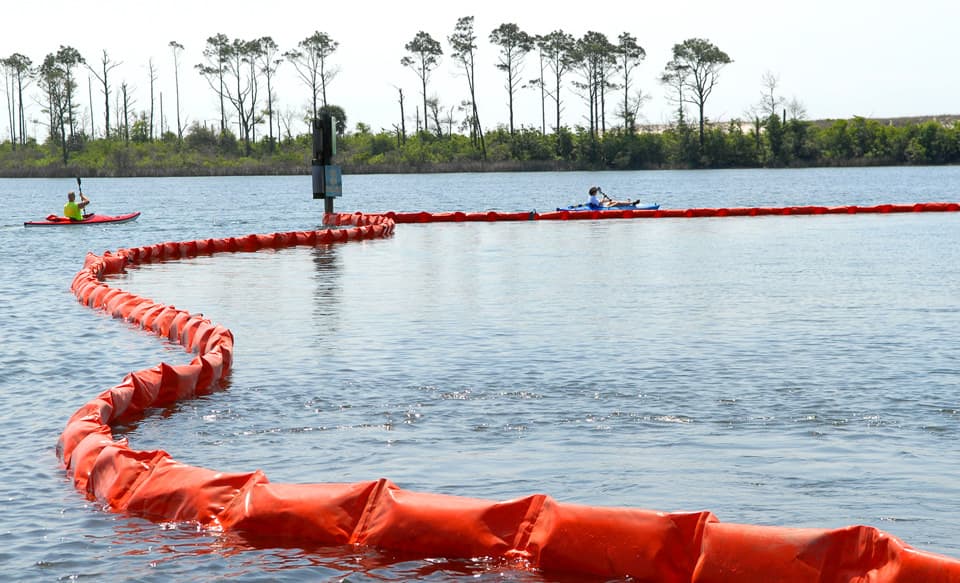Ten Common Words with Uncommon Meanings in Spill Response
Here a few common words that have special meaning in context of responding to oil and chemical spills in the ocean.

Kayakers at Naval Air Station Pensacola detour around oil containment boom on base at Sherman Cove, Pensacola, Florida, on May 4, 2010. The boom was set to protect environmentally sensitive grass beds from the Deepwater Horizon oil spill. Credit: U.S. Department of Defense
-
1. Boom
Not the loud deep resonating sound described in a dictionary. In oil response, booms are floating, physical barriers to oil, made of plastic, metal, or other materials, which slow the spread of oil and keep it contained. Read more on the history of booms in spill response.
-
2. Crude
A vulgar comment? Nope. In this case the spill response definition fits more into the traditional understanding of the word: something in a raw or an unrefined state. Crude oil is unrefined petroleum, usually liquid, consisting of a mixture of hydrocarbons. Crude oil may be refined into any of hundreds of components, such as commercial gasoline, kerosene, heating oils, diesel oils, lubricating oils, waxes, and asphalts. Read more on crude and other oil types.
-
3. Hazing
Usually defined as a rigorous initiation process into an organization of some sort, "hazing" methods in spill response indicate tactics used to keep whales out of harm’s way. Read more about hazing methods.
-
4. Mousse
The first thing that pops into the mind when someone uses the word mousse is that silky pudding-like dessert, or a product to sculpt unruly hair. In spill response, mousse is a term to describe a water-in-oil emulsion that resembles chocolate mousse in color and texture. These emulsions are often very stable, and often have a pudding-like consistency. Typically, a mousse forms when relatively fresh oil is exposed to strong wave action. Mousse colors can range from orange or tan to dark brown. A mousse may contain up to 75 percent water, and may have a volume up to four times that of the original oil. Learn how to make an oil and water mousse.
-
5. Pancakes
Nope, not the breakfast food. In this case pancakes refer to isolated, roughly circular patches of spilled oil ranging in size from a few feet across to hundreds of yards (or meters) in diameter. These oil patches can form tarballs sometimes found along sandy beaches. Read more on tarballs.
-
6. Pom-Poms (or Pom-Pons)
Similar to the equipment used by many a cheer-squad member, pom-poms in spill response are used to absorb oil for removal. Made of synthetic fibers, pom-poms are used individually or tied on long ropes and used to catch oil as it leaches from beaches and rocky areas. Strings of pom-poms are effective in collecting oil in rock or difficult to reach areas where the tide rises and falls. Read about how pom-poms were used to cleanup an oil spill.
-
7. SOS
Save our ship? How about Science of Oil Spills. Every year, NOAA's Response and Restoration Emergency Response Division educates emergency spill responders to increase understanding of oil spill science. Read about SOS classes.
-
8. Slick
Typically defined as something done in a smooth way, a slick is the common term used to describe a film of oil (usually less than two microns thick) on the water surface. Oil spilled on water absorbs energy and dampens out surface waves, making the oil appear smoother—or slicker—than the surrounding water. Read about oil slicks and sea turtles.
-
9. Streamer
Those paper ribbons hanging from the ceiling at a party, right? Wrong. In spill response a streamer, also called fingers or ribbons, are narrow lines of oil, mousse, or sheen on the water surface, surrounded on both sides by clean water. Streamers result from the combined effects of wind, currents, and/or natural convergence zones. Often, heavier concentrations of mousse or sheen will be present in the center of a streamer, with progressively lighter sheen along the edges. Read about techniques for cleaning up streamers in oil spills.
-
10. Weathering
In this instance, the meaning used in spill response is similar to the general definition. In oil response, weathering is the physical and chemical characteristics of oil interacting with the physical and biochemical features of the habitat where a spill occurs. These factors determine how the oil will behave and ultimately what will happen to it. Read more about weathering.
Search Our Posts
Get Social
More Information
Did You Know?
Every year NOAA responds to more than a hundred oil and chemical spills in U.S. waters, which threaten life, property, and public natural resources. Spills into our coastal waters, whether accidental or intentional, can harm people and the environment and substantially disrupt marine transportation with potential widespread economic impacts. The Office of Response and Restoration (OR&R) is charged with responding to oil spills, chemical accidents, and other emergencies in coastal areas. Under the National Contingency Plan, NOAA is responsible for providing scientific support to the Federal On-Scene Coordinator for oil and hazardous material spills. To support this mandate, OR&R provides 24/7 response to spills.

Last updated: 06/16/24
Author: NOAA
How to cite this article
This story first appeared on NOAA's Response and Restoration blog in January 2017.